Gardeners find compost to be a powerful tool for a healthy garden. Composting turns kitchen scraps and yard waste into nutrient-rich soil. This soil boosts plant growth and helps your garden thrive. Composting reduces waste and supports essential organisms in your garden.
Compost is like a vitamin for your plants, offering slow-releasing nutrients. Your plants will grow stronger and live longer because of it.1 Plus, it saves you money by replacing the need for store-bought fertilizers. No matter the size of your living space, composting at home is doable and beneficial.
Key Takeaways
- Composting helps recycle organic materials and reduce waste, while creating nutrient-rich soil for your garden.
- Compost supports a healthy ecosystem in your yard by feeding microorganisms, insects, and other garden helpers.
- Using compost in your garden can save you money on chemical fertilizers and other soil amendments.
- Composting can be done in a variety of spaces, from a large outdoor area to a small patio or balcony.
- With the right techniques, you can successfully compost at home and enjoy the many benefits it provides for your plants and garden.
Why Compost at Home?
Composting is great for the environment. It cuts down on waste that fills up landfills.2 Nearly 30% of our trash is food scraps and yard waste. Sadly, only 6% of this is composted because waste systems are centered around landfills. When you compost at home, you keep this waste out of the trash and turn it into nutrient-rich soil for your plants.
Environmental Benefits of Composting
Since 2012, San Francisco has kept over 80% of its waste away from landfills. This big move avoids more than 90,000 metric tons of carbon emissions yearly. By composting at home, you help lessen greenhouse gases and landfill loads.
Enriching Garden Soil with Compost
Compost is not just trash; it’s a super-powered fertilizer. It boosts your soil’s health and makes it more fertile.2 For every 1% more organic matter in soil, it can hold 20,000 extra gallons of water. This is a big deal, especially for areas that don’t see much rain. Adding your own compost to your garden enriches the soil. It helps your plants grow stronger and look better.
Cost-Effective Gardening with Compost
Dumping trash into a landfill cost the U.S. about $55 per ton in 2019. Composting at home is a way to cut costs and not rely on costly chemical fertilizers.2 The average American family throws away $150 of food each month. That discarded food could instead improve your soil by composting it. So, composting isn’t just earth-friendly; it saves you money too.
Composting at home gives both green and financial perks. By doing it, you cut waste, boost soil, and spend less. It’s a win for your garden, your wallet, and the planet.
What is Compost?
Compost is made from decomposing organic matter. This includes things like fallen leaves, grass, and kitchen scraps.2 It’s known as the gardener’s secret weapon because it’s great for soil.
Compost: The Gardener’s Secret Weapon
It’s fantastic for soil that’s sandy, clay, or loamy. It makes soil better by adding structure, holding more water, and giving plants nutrients.2 In short, it makes any soil a perfect bed for plants.
Composting Amends Soil Issues
Compost improves how soil holds water, its structure, and the nutrients it has. Using compost in your garden turns bad soil into a rich, fertile place for plants to grow.
Where to Compost
Composting is possible in big spaces like a yard or small ones like a balcony.3 You can find community gardens with several compost bins. But, a simple heap in your yard can work well too.3
Composting Spaces: From Large to Small
You don’t always need a bin for compost. Just make sure your compost pile is big enough, around 4 feet in every direction.3 Still, some people prefer using a compost bin to keep things neat.
Are Compost Bins Necessary?
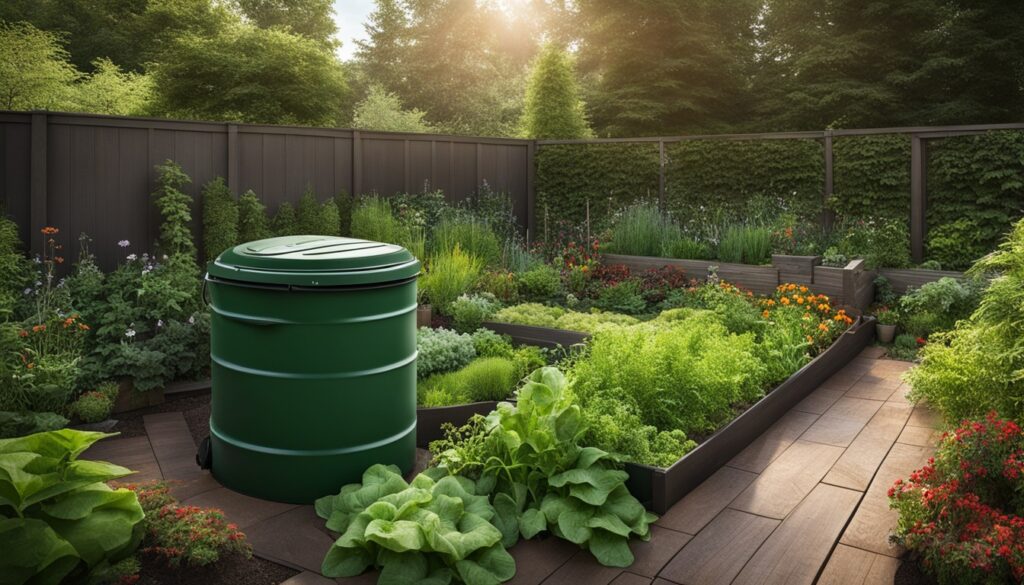 You can design a composting area for any space, like a small balcony or a large yard.3 Whether it’s a pile or a bin, it must have the right size, air, and moisture for decomposition to happen efficiently.3
You can design a composting area for any space, like a small balcony or a large yard.3 Whether it’s a pile or a bin, it must have the right size, air, and moisture for decomposition to happen efficiently.3
| Composting Space Requirements | Compost Bin Options |
|---|---|
| Minimum pile size: 4 ft x 4 ft x 4 ft3 | Wire fencing, cement block, barrel, wood, or three-chambered bins3 |
| Optimal pile size: 3 to 5 feet in each direction3 | Flexibility based on space and material availability3 |
| Enclosed piles maintain higher temperatures3 | Contained piles keep the composting process tidy3 |
In a big yard or a little space, you can make a great spot for composting. Choose a setup that helps things break down naturally. This could be a plain pile outside or a special bin.3
What Can Be Composted?
When composting at home, it’s key to know what to put in. You can add many things, like leaves, grass, and old newspapers. Also, veggies scraps and any uneaten food are great.2 These food scraps and garden leftovers are over a quarter of what’s thrown away.2
Compostable Materials
On top of food and yard waste, you can toss in coffee grounds and eggshells. Even pet bedding and certain nutshells are okay.2
Non-Compostable Items
But, some things don’t belong in your compost. These are items like glass and pet waste. Also, avoid putting in meat, bones, and dairy.2
How Do You Compost at Home
Essential Ingredients for a Healthy Compost Pile
Creating a good compost pile needs four key parts: brown and green stuff, water, and air.4 The best mix for compost is 25:1 to 40:1 carbon to nitrogen. Finished compost should have a ratio of 20 – 25:1.4
Preparing Compost Ingredients
Chopping or shredding ingredients helps them break down faster. This lets more microbes get to the material.1 It’s also important to keep the pile moist but not too wet, around 50-60%. Plus, the pile should have enough air.4
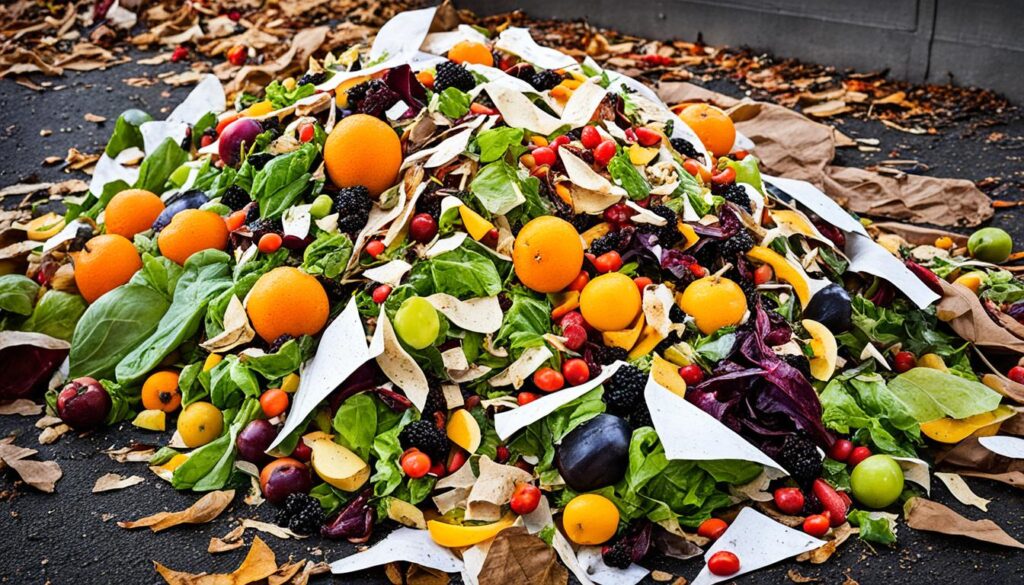
Use straw, wood chips, and leaves for brown materials. For greens, try grass, weeds, and kitchen scraps.1 A good mix of brown and green materials, water, and airflow speeds up decomposition in a compost pile.1
Hot Composting vs. Cold Composting
Composting has two main methods: hot (also known as active) and cold (also called passive). Each has its own perks, rules, and timing. Gardeners pick the one that fits their needs best.5
Hot (Active) Composting Method
In active composting, you mix brown and green materials in the right amounts. This keeps the pile’s temperature high, at 141°F to 155°F.5 You need to turn and check the pile often to keep it moist and airy. A well-done hot compost pile will warm up fast, in a day or two, and stay hot for days or even weeks.5 The high heat in this process kills off weed seeds and harmful germs quickly. But, it does demand more work from the gardener.
Cold (Passive) Composting Method
Cold composting is much easier and hands-off. It lets nature take its course over time. Unfortunately, it can take a year or two to turn into useful compost for the garden.5 The speed of cold composting depends on the materials’ size and their mix. Small bits decompose faster.5 But, you must be careful to not add weed seeds or sick plants. They might not fully break down and can spread disease in your garden.
Both hot and cold composting have their good points. Choosing between them depends on how much time and space you have, and what you want to get out of it. By knowing how they work, gardeners can make an informed choice. This choice fits best with their gardening plans and lifestyle.
Building a Simple Compost Pile
Start your compost pile with a layer of carbon-rich “brown” materials. Use things like cardboard, wood chips, or shredded paper.6 Aim for two parts of browns for every green part.6 Then, add nitrogen-rich “green” items such as grass clippings or kitchen scraps. Follow them with a bit of soil.
Maintaining Moisture and Aeration
Keeping the right moisture level (like a damp sponge) and adding enough air are key.6 It’s crucial to keep your compost pile moist. The suggestion is to get only one drop of water when squeezing a fistful of compost.6 Turning your compost pile mixes it, bringing in oxygen and helping it decompose faster.
For the best compost, aim for a pile temperature of 100-140 degrees Fahrenheit.6 It takes about two to four days to hit this perfect temp.6 Turning the pile often speeds up the process. It might be ready in as little as 18 days by turning it every other day.6 Your compost pile should be at least 3 feet wide and 3 feet high. This size allows for the best heat and decomposition activity.6
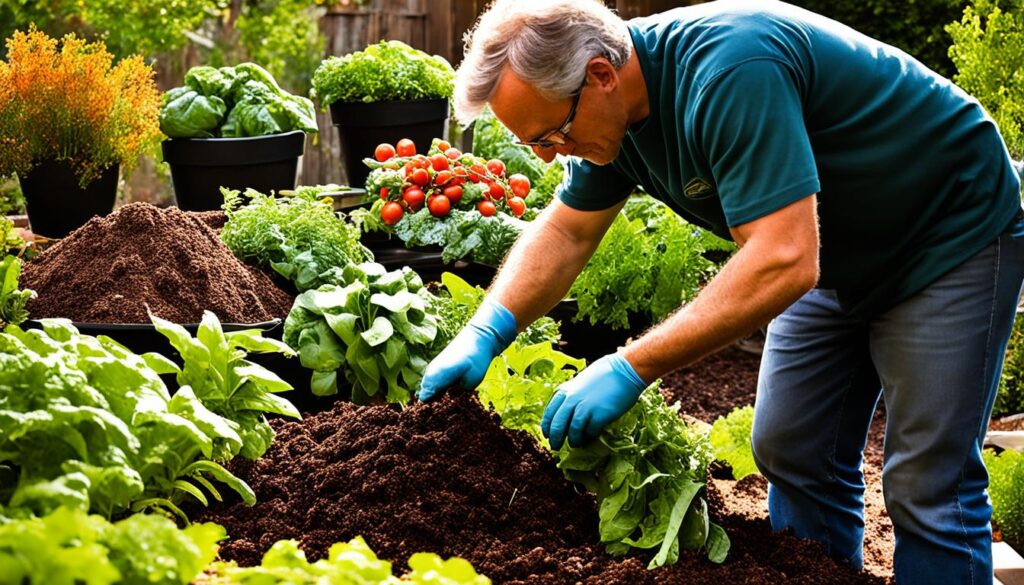
Turning the Compost Pile
Turning the compost pile is crucial in making good compost. When the pile’s inside starts to cool, it’s ready to be turned.7 Using a pitchfork or another tool, move the materials around. This flips the pile and adds oxygen. It also mixes everything well. By turning it every few days to a few weeks, the composting process stays hot.7
It’s best to turn a compost tumbler every three to four days and the compost pile every three to seven days.7 If your compost is slow to break down or smells bad, you might need to turn it more often.7 Airing out the compost by turning it lets the helpful microbes work better. This makes everything decompose faster.7 If the pile gets too hot, turning it cools things down. This keeps the compost at the right temperature for breaking down materials.7
Actively decomposing materials should be turned every few days.8 You can turn materials that decompose slowly less frequently.8 Tumblers were found to produce hotter compost faster by being turned two times a week.8 Frequent turning keeps the compost very hot, which is good for breaking down materials.8
To add air, you can use a compost tumbler or turn it with a pitchfork or shovel.7 The size of the pile, the mix of green and brown materials, and how wet it is, affect how often it should be turned.7
| Compost Turning Recommendations | Frequency |
|---|---|
| Compost Tumbler | Every 3-4 days7 |
| Compost Pile | Every 3-7 days7 |
| Actively Decomposing Materials | Every 3-4 days8 |
| Slowed Microbial Activity Materials | Less often8 |
Troubleshooting Common Compost Issues
Even with top-notch Compost Troubleshooting, common problems like bad smells and pests can show up. It’s important to control the smell of the compost. Bad odors often come from too much green or brown stuff. Or from not enough air getting in.9 You can fix this by adding more brown stuff. Also, make sure to turn the pile often or cover it with soil or finished compost. Compost Pest Management is a must too. Rodents and bugs might be drawn to your compost pile.9 To keep them away, bury your kitchen scraps. Also, use a contained area or a sealed bin for compost.9 Keeping the right balance of materials and the correct environment in your pile can prevent these issues.
Dealing with Odors
If your compost smells bad, it could be from too little carbon or nitrogen. Or it might need more air.9 You can fix this by adding more dry leaves, paper, or straw. This helps balance the compost mix.9 Turning the pile more can add oxygen and stop the smelly stuff from forming.9 Putting a layer of finished compost or soil on top can also lock in bad smells.
Handling Pests
Rodents, insects, and pets may find your compost interesting but they mess with its breakdown.9 You can keep them away by burying scraps deeper, using a closed bin, or putting soil on top of the pile.9 Also, keeping the compost at the right moisture and well-aerated helps make it less attractive to pests.9
Solving Compost Troubleshooting problems helps your pile stay healthy. That way, it won’t smell bad and uninvited guests won’t join. This leads to great soil for your garden.
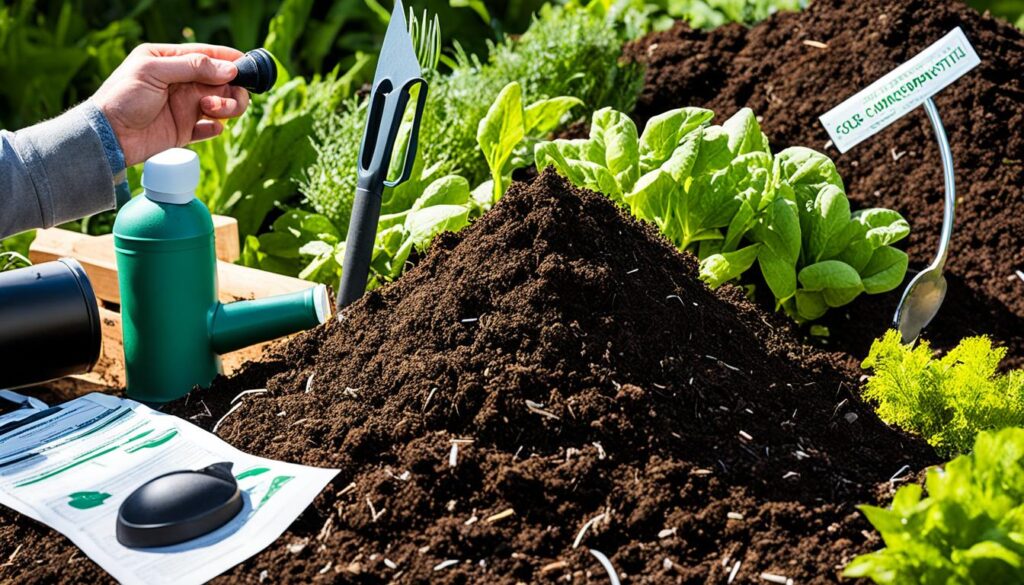
Using Finished Compost
When your compost is ready, it works great in garden soil. It makes the soil better for plants.10 Good compost feels crumbly and looks dark like ‘black gold’.10 It smells sweet and fresh, not like ammonia.10
Incorporating Compost into Garden Soil
Compost helps with soil that’s too wet or too dry.10 It slowly gives nutrients to plants. This makes the soil better for them to grow in.10 Spread one to three inches of compost over the soil. Then mix it into the top four to eight inches. This is best done in fall. Doing it then helps the compost to fully do its job without harming the soil.11
Compost Tea and Other Uses
Compost tea and other uses are great for plants.11 You can make compost tea. It’s a powerful, all-natural drink for your garden.11 There’s a lot you can do with compost. Use it in the soil for different plants. Put it around trees and shrubs to make the soil there better too.10
Compost is a great thing for your garden. It comes from your home, and it’s full of benefits.101112
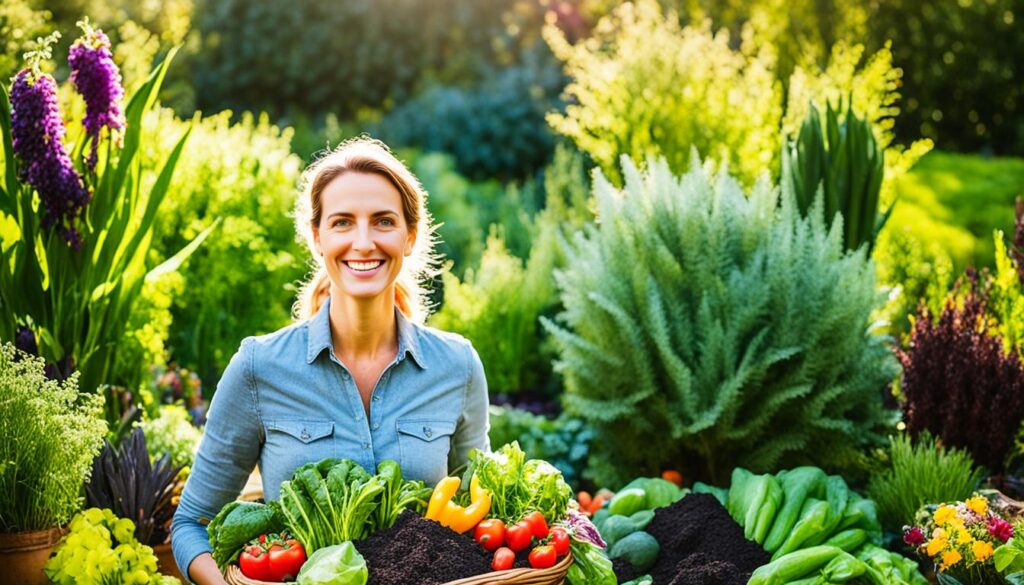
Conclusion
Composting at home helps both gardeners and the planet. It cuts down on trash in landfills.13 Plus, it makes soil richer, which is great for plants. Compost is like magic for your garden.
Even with a small space, you can compost at home.14 Just learn the right way and fix any issues.15 This method is good for your garden and the Earth.
Adding compost to your garden makes the soil better for plants.14 It helps the soil hold water and gives plants what they need to grow. Composting is a smart way to care for your garden. Start today and see the good it does for your plants.
FAQ
What are the benefits of composting at home?
Composting at home helps cut waste and makes rich soil. This soil is great for gardens. It also saves money by reducing the need for chemical fertilizers.
What is compost and how can it improve my garden?
Compost is like soil and is made from old plant or food matter. It makes the soil better for plants. Compost helps the soil hold water and provides food for plants.
What materials can be composted at home?
You can compost many things like leaves, grass, and food scraps. But, stay away from items like plastics, meat, and pet waste. These things don’t break down well.
How do I set up a compost pile at home?
Setting up a compost pile is easy. Start with a layer of brown materials. Then, layer green materials on top. Make sure the pile stays moist and gets enough air.
What are the differences between hot and cold composting?
Hot composting makes piles that are very warm and active. Cold composting lets nature break things down slowly. Hot composting is fast but needs more work. Cold composting is easier but is slower.
How do I troubleshoot common compost issues?
Bad smells or bugs in your compost can be fixed. Balance your compost with more browns or greens. Keep it turned and well-contained. Good care is the key to a happy compost.
How can I use finished compost in my garden?
Put your finished compost in your garden to help plants grow. You can also make compost tea. This tea is great for feeding plants by spray or watering them with it.
Source Links
- https://www.almanac.com/how-compost-guide-composting-home
- https://www.nrdc.org/stories/composting-101
- https://extension.umn.edu/managing-soil-and-nutrients/composting-home-gardens
- https://extension.umd.edu/resource/how-make-compost-home
- https://www.finegardening.com/article/hot-composting-vs-cold-composting
- https://homesteadingfamily.com/how-to-make-compost-the-easy-way/
- https://www.gardeningknowhow.com/composting/basics/turning-compost-pile.htm
- https://extension.okstate.edu/fact-sheets/compost-turning-the-key-to-quick-composting.html
- https://www.growveg.com/guides/how-to-fix-common-compost-problems/
- https://learn.eartheasy.com/articles/how-to-use-finished-compost/
- https://greenactioncentre.ca/reduce-your-waste/harvesting-your-compost/
- https://squarefoot.forumotion.com/t14421-how-do-you-separate-finished-compost-from-ongoing-compost
- https://usfblogs.usfca.edu/sustainability/2020/05/18/my-composting-journey/
- https://www.finegardening.com/article/get-started-in-composting
- https://durhammastergardeners.com/2018/01/25/consider-composting/
